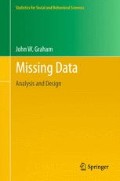Abstract
One of the most difficult problems with performing multiple imputation relates to having too many variables in the imputation model. In many instances, the problems associated with having too many variables in the model can be avoided by using the strategies suggested in the previous chapter. Still, situations arise in which more variables need to be included in the model than can feasibly be handled by the current software. In this chapter, we reiterate the “Think FIML” approach to multiple imputation, which will help you avoid many pitfalls in this regard. Also, for situations in which the Think FIML approach is not enough, we describe two other strategies for dealing with this problem. The first strategy involves reducing the number of variables by imputing whole scales rather than the individual items making up the scales. The second strategy involves dividing up the variables into two or more sets that can be imputed separately with minimal bias.
Access this chapter
Tax calculation will be finalised at checkout
Purchases are for personal use only
Notes
- 1.
One could consider other approaches to making these judgments about unidimensionality and homogeneity. For example, one could consider using tools of exploratory factor analysis (e.g., the scree test) to verify that the items making up a scale do indeed form a single factor. One could also use the SEM framework to help make judgments about whether the scale items tap a single factor, and whether it is reasonable in a statistical sense to treat the factor loadings to be equal, that is, to be homogeneous.
References
Graham, J. W. (2009). Missing data analysis: making it work in the real world. Annual Review of Psychology, 60, 549–576.
Graham, J. W., & Hofer, S. M. (2000). Multiple imputation in multivariate research. In T. D. Little, K. U. Schnabel, & J. Baumert, (Eds.), Modeling longitudinal and multiple-group data: Practical issues, applied approaches, and specific examples. (pp. 201–218). Hillsdale, NJ: Erlbaum.
Graham, J. W., Cumsille, P. E., & Elek-Fisk, E. (2003). Methods for handling missing data. In J. A. Schinka & W. F. Velicer (Eds.). Research Methods in Psychology (pp. 87–114). Volume 2 of Handbook of Psychology (I. B. Weiner, Editor-in-Chief). New York: John Wiley & Sons.
Schafer, J. L. (1997). Analysis of Incomplete Multivariate Data. New York: Chapman and Hall.
Schafer, J. L., & Graham, J. W. (2002). Missing data: our view of the state of the art. Psychological Methods, 7, 147–177.
Author information
Authors and Affiliations
Rights and permissions
Copyright information
© 2012 Springer Science+Business Media New York
About this chapter
Cite this chapter
Graham, J.W., Van Horn, M.L., Taylor, B.J. (2012). Dealing with the Problem of Having Too Many Variables in the Imputation Model. In: Missing Data. Statistics for Social and Behavioral Sciences. Springer, New York, NY. https://doi.org/10.1007/978-1-4614-4018-5_9
Download citation
DOI: https://doi.org/10.1007/978-1-4614-4018-5_9
Published:
Publisher Name: Springer, New York, NY
Print ISBN: 978-1-4614-4017-8
Online ISBN: 978-1-4614-4018-5
eBook Packages: Mathematics and StatisticsMathematics and Statistics (R0)

